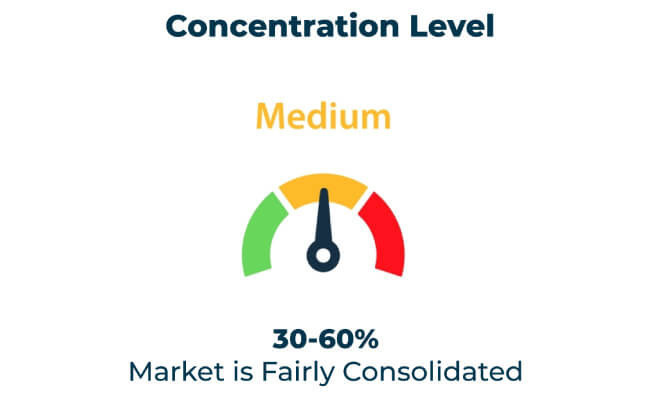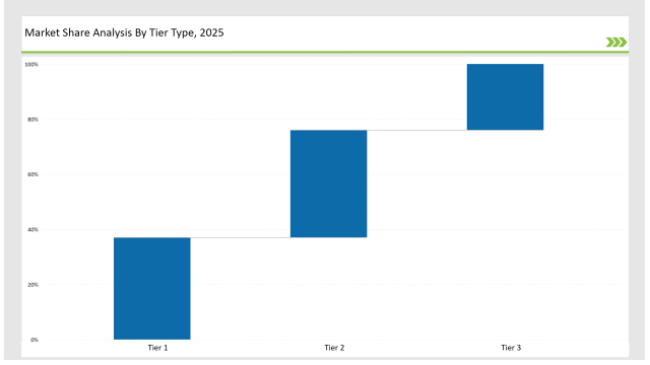The foil labels market is additionally expected to burgeon, as a highly developed packaging solution for aesthetics and durability together with safety is also sought by brands. Conventional food and beverage, cosmetics, pharmaceuticals, and electronics demand more and more such innovations from manufacturers through holographic finishes, embossing techniques, or eco-friendly metallic alternatives. Moreover, companies innovated anti-counterfeiting features and recyclable materials in combination with more advanced printing techniques that further enhance sustainability as well as brand differentiation.
Manufacturers are putting resources into AI-driven quality control, high-speed foil stamping, and precise die-cutting to attain production efficiency. The trend is leaning toward biodegradable foil labels light in weight but blisteringly gross in premium experience while reducing the ecological footprint.
37% of this market comprises Tier 1 players, like Avery Dennison, UPM Raflatac, and CCL Industries, on the basis of leadership in innovative sustainable labelling solutions, advanced printing technology, and global supply chain network.
Tier 2 includes companies making lower specialization like Multicolor Corporation, Constantia Flexibles, and 3M, which already together amount up to 39% of the market because they offer relatively cheap custom specialty foil labels for luxurious packaging and anti-counterfeiting applications.
These remaining 24% of the market share belong to the Tier 3 category, which consists of regional and niche players mainly in holographic, embossed, and tamper-evident foil labels. Their focus is mainly on local production concentrating on inventions in security features and eco-friendliness.
Explore FMI!
Book a free demo
Global Market Share by Key Players (2025)
| Category | Market Share (%) |
|---|---|
| Top 3 (Avery Dennison, UPM Raflatac, CCL Industries) | 19% |
| Rest of Top 5 (Multi-Color Corporation, Constantia Flexibles) | 12% |
| Next 5 of Top 10 (3M, Kurz, Fort Dearborn, All4Labels, Toppan Printing) | 6% |

The foil labels industry serves multiple sectors where visual appeal, security, and sustainability are crucial. Companies are adopting premium labeling solutions to strengthen brand identity and meet regulatory standards. They are integrating smart tracking features to enhance supply chain transparency and reduce counterfeiting risks.
Manufacturers are optimizing foil labels with sustainable materials, high-gloss finishes, and smart tracking features. They are integrating advanced printing techniques to improve color vibrancy and precision. Additionally, companies are developing ultra-thin metallic layers to enhance flexibility without compromising durability. Businesses are also incorporating tamper-proof micro-embossing to strengthen security and product authenticity.
Sustainability and digital transformation are redefining the foil labels industry. Companies are integrating AI-driven defect detection, sustainable metallic coatings, and advanced finishing techniques to improve performance. Businesses are developing ultra-thin foil labels to reduce material usage. Manufacturers are launching anti-counterfeit, micro-text printed labels for enhanced security. Additionally, firms are embedding NFC chips in foil labels for supply chain transparency and consumer engagement.
Technology suppliers should focus on automation, digital branding enhancements, and smart label advancements to support the evolving foil labels market. Partnering with luxury brands, pharmaceuticals, and e-commerce businesses will accelerate innovation and adoption.
| Tier Type | Example of Key Players |
|---|---|
| Tier 1 | Avery Dennison, UPM Raflatac, CCL Industries |
| Tier 2 | Multi-Color Corporation, Constantia Flexibles, 3M |
| Tier 3 | Kurz, Fort Dearborn, All4Labels, Toppan Printing |

Leading manufacturers are advancing foil label technology with AI-powered defect detection, sustainable coatings, and anti-counterfeit features. Companies are refining ultra-thin label designs to reduce material usage while maintaining durability. Additionally, businesses are expanding interactive smart labels to engage consumers and track product authenticity. Manufacturers are also optimizing energy-efficient printing techniques to reduce carbon footprints.
| Manufacturer | Latest Developments |
|---|---|
| Avery Dennison | Launched biodegradable metallic foil labels in March 2024. |
| UPM Raflatac | Developed heat-resistant and UV-protected foil labels in April 2024. |
| CCL Industries | Expanded tamper-evident, high-gloss foil label solutions in May 2024. |
| Multi-Color Corp | Released holographic foil labels for luxury packaging in June 2024. |
| Constantia Flexibles | Strengthened pressure-sensitive foil labels in July 2024. |
| 3M | Introduced NFC-enabled foil labels for smart packaging in August 2024. |
| Kurz | Pioneered ultra-thin, fully recyclable foil labels in September 2024. |
The foil labels market is evolving as companies invest in sustainable materials, AI-driven defect detection, and smart tracking features. They are enhancing printing techniques to improve label durability and visual appeal. Additionally, manufacturers are integrating ultra-thin foil coatings to reduce material consumption without compromising quality. Businesses are also expanding the use of tamper-proof and serialized labeling to strengthen brand protection and security.
Manufacturers will continue refining AI-driven quality control, ultra-thin foil label technology, and interactive digital branding. Companies will expand sustainable metallic ink solutions to meet eco-friendly packaging regulations. Businesses will enhance anti-counterfeit features with micro-text and holography. NFC and QR-enabled labels will drive consumer engagement and product authentication. Additionally, AI-powered analytics will optimize printing efficiency and reduce material waste.
Leading players include Avery Dennison, UPM Raflatac, CCL Industries, Multi-Color Corporation, Constantia Flexibles, 3M, and Kurz.
The top 3 players collectively control 19% of the global market.
The market shows medium concentration, with top players holding 37%.
Key drivers include sustainability, anti-counterfeit technology, digital printing, and smart labeling solutions.
Sustainable Packaging Market Trends – Innovations & Growth 2025 to 2035
Ultra High Bond (UHB) Tape Market Analysis by Type, Thickness and End Use Through 2035
Thermoforming Machines Market Trends - Demand & Forecast 2025 to 2035
Strapping and Banding Equipment Market – Key Trends & Growth Outlook 2025 to 2035
Strapping Devices Market Trends - Size, Growth & Forecast 2025 to 2035
Specialty Pulp and Paper Chemicals Market Analysis – Growth & Forecast 2025 to 2035

Thank you!
You will receive an email from our Business Development Manager. Please be sure to check your SPAM/JUNK folder too.